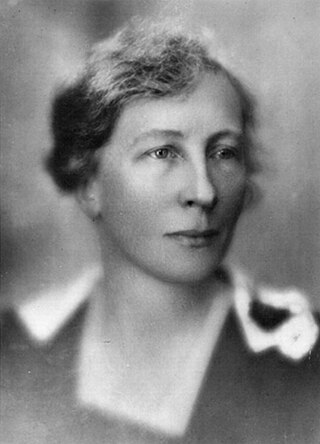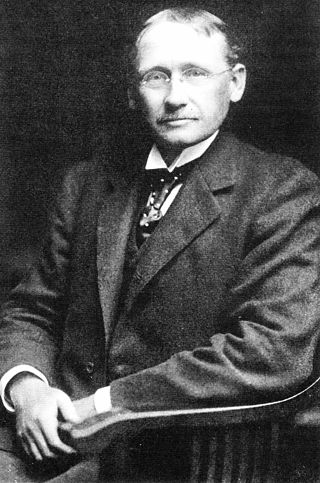Related Research Articles
Industrial and organizational psychology "focuses the lens of psychological science on a key aspect of human life, namely, their work lives. In general, the goals of I-O psychology are to better understand and optimize the effectiveness, health, and well-being of both individuals and organizations." It is an applied discipline within psychology and is an international profession. I-O psychology is also known as occupational psychology in the United Kingdom, organisational psychology in Australia and New Zealand, and work and organizational (WO) psychology throughout Europe and Brazil. Industrial, work, and organizational (IWO) psychology is the broader, more global term for the science and profession.

Lillian Evelyn Gilbreth was an American psychologist, industrial engineer, consultant, and educator who was an early pioneer in applying psychology to time-and-motion studies. She was described in the 1940s as "a genius in the art of living." Gilbreth, one of the first female engineers to earn a Ph.D., is considered to be the first industrial/organizational psychologist. She and her husband, Frank Bunker Gilbreth, were efficiency experts who contributed to the study of industrial engineering, especially in the areas of motion study and human factors. Cheaper by the Dozen (1948) and Belles on Their Toes (1950), written by two of their children tell the story of their family life and describe how time-and-motion studies were applied to the organization and daily activities of their large family. Both books were later made into feature films.

Automation describes a wide range of technologies that reduce human intervention in processes, namely by predetermining decision criteria, subprocess relationships, and related actions, as well as embodying those predeterminations in machines. Automation has been achieved by various means including mechanical, hydraulic, pneumatic, electrical, electronic devices, and computers, usually in combination. Complicated systems, such as modern factories, airplanes, and ships typically use combinations of all of these techniques. The benefit of automation includes labor savings, reducing waste, savings in electricity costs, savings in material costs, and improvements to quality, accuracy, and precision.

Scientific management is a theory of management that analyzes and synthesizes workflows. Its main objective is improving economic efficiency, especially labor productivity. It was one of the earliest attempts to apply science to the engineering of processes to management. Scientific management is sometimes known as Taylorism after its pioneer, Frederick Winslow Taylor.
Productivity is the efficiency of production of goods or services expressed by some measure. Measurements of productivity are often expressed as a ratio of an aggregate output to a single input or an aggregate input used in a production process, i.e. output per unit of input, typically over a specific period of time. The most common example is the (aggregate) labour productivity measure, one example of which is GDP per worker. There are many different definitions of productivity and the choice among them depends on the purpose of the productivity measurement and data availability. The key source of difference between various productivity measures is also usually related to how the outputs and the inputs are aggregated to obtain such a ratio-type measure of productivity.
Video production is the process of producing video content for video. It is the equivalent of filmmaking, but with video recorded either as analog signals on videotape, digitally in video tape or as computer files stored on optical discs, hard drives, SSDs, magnetic tape or memory cards instead of film stock. There are three stages of video production: pre-production, production, and post-production. Pre-production involves all of the planning aspects of the video production process before filming begins. This includes scriptwriting, scheduling, logistics, and other administrative duties. Production is the phase of video production which captures the video content and involves filming the subject(s) of the video. Post-production is the action of selectively combining those video clips through video editing into a finished product that tells a story or communicates a message in either a live event setting, or after an event has occurred (post-production).

A time and motion study is a business efficiency technique combining the Time Study work of Frederick Winslow Taylor with the Motion Study work of Frank and Lillian Gilbreth. It is a major part of scientific management (Taylorism). After its first introduction, time study developed in the direction of establishing standard times, while motion study evolved into a technique for improving work methods. The two techniques became integrated and refined into a widely accepted method applicable to the improvement and upgrading of work systems. This integrated approach to work system improvement is known as methods engineering and it is applied today to industrial as well as service organizations, including banks, schools and hospitals.

Operations management is concerned with designing and controlling the production of goods or services, ensuring that businesses are efficient in using resources to meet customer requirements.

Dennis Muren, A.S.C is an American film visual effects artist and supervisor. He has worked on the films of George Lucas, Steven Spielberg, and James Cameron, among others, and has won nine Oscars in total: eight for Best Visual Effects and a Technical Achievement Academy Award. The Visual Effects Society has called him "a perpetual student, teacher, innovator, and mentor."
Muda is a Japanese word meaning "futility", "uselessness", or "wastefulness", and is a key concept in lean process thinking such as in the Toyota Production System (TPS), denoting one of three types of deviation from optimal allocation of resources. The other types are known by the Japanese terms mura ("unevenness") and muri ("overload"). Waste in this context refers to the wasting of time or resources rather than wasteful by-products and should not be confused with Waste reduction.
Methods-Time Measurement (MTM) is a predetermined motion time system that is used primarily in industrial settings to analyze the methods used to perform any manual operation or task and, as a product of that analysis, set the standard time in which a worker should complete that task.
Organizational behavior management (OBM) is a subdiscipline of applied behavior analysis (ABA), which is the application of behavior analytic principles and contingency management techniques to change behavior in organizational settings. Through these principles and assessment of behavior, OBM seeks to analyze and employ antecedent, influencing actions of an individual before the action occurs, and consequence, what happens as a result of someone's actions, interventions which influence behaviors linked to the mission and key objectives of the organization and its workers. Such interventions have proven effective through research in improving common organizational areas including employee productivity, delivery of feedback, safety, and overall morale of said organization.
Lean Six Sigma is a process improvement approach that uses a collaborative team effort to improve performance by systematically removing operational waste and reducing process variation. It combines Lean Management and Six Sigma to increase the velocity of value creation in business processes.

Industrial engineering is an engineering profession that is concerned with the optimization of complex processes, systems, or organizations by developing, improving and implementing integrated systems of people, money, knowledge, information and equipment. Industrial engineering is central to manufacturing operations.
Economics of participation is an umbrella term spanning the economic analysis of worker cooperatives, labor-managed firms, profit sharing, gain sharing, employee ownership, employee stock ownership plans, works councils, codetermination, and other mechanisms which employees use to participate in their firm's decision making and financial results.

Human factors and ergonomics is the application of psychological and physiological principles to the engineering and design of products, processes, and systems. Primary goals of human factors engineering are to reduce human error, increase productivity and system availability, and enhance safety, health and comfort with a specific focus on the interaction between the human and equipment.
Process capital is the value to an enterprise which is derived from the techniques, procedures, and programs that implement and enhance the delivery of goods and services. Process capital is one of the three components of structural capital, itself a component of intellectual capital. Process capital can be seen as the value of processes to any entity, whether for profit or not-for profit, but is most commonly used in reference to for-profit entities.
Industrial and production engineering (IPE) is an interdisciplinary engineering discipline that includes manufacturing technology, engineering sciences, management science, and optimization of complex processes, systems, or organizations. It is concerned with the understanding and application of engineering procedures in manufacturing processes and production methods. Industrial engineering dates back all the way to the industrial revolution, initiated in 1700s by Sir Adam Smith, Henry Ford, Eli Whitney, Frank Gilbreth and Lilian Gilbreth, Henry Gantt, F.W. Taylor, etc. After the 1970s, industrial and production engineering developed worldwide and started to widely use automation and robotics. Industrial and production engineering includes three areas: Mechanical engineering, industrial engineering, and management science.
The Gilbreth Medal is named after Frank Bunker Gilbreth Sr. and Lillian Gilbreth and is presented in recognition of excellence int he field of motion, skill, and fatigue study. Originally awarded in 1931 by the Society of Industrial Engineers the award continues to be presented following the organizations merger in 1936 with The Taylor Society under the new organization, The Society for Advancement of Management.

Annie "Anne" Gillespie Shaw CBE was a Scottish engineer and businesswoman. Shaw specialised in time and motion studies. In 1945, she founded the Anne Shaw Organisation Ltd, a consulting company.
References
- ↑ Mundel, Marvin Everett: Systematic Motion and time study : improving productivity. Englewood Cliffs, N. J.: Prentice Hall, 1946. The book became a standard und was published by David Danner (ed.) as Motion and time study : improving productivity. in 7th ed. 1994 with ISBN 0-13-588369-5.
- ↑ Norbury, Clifford J.: The Application of Memo-Motion to Industrial Operations. Cranfield : College of Aeronautics, 1954.